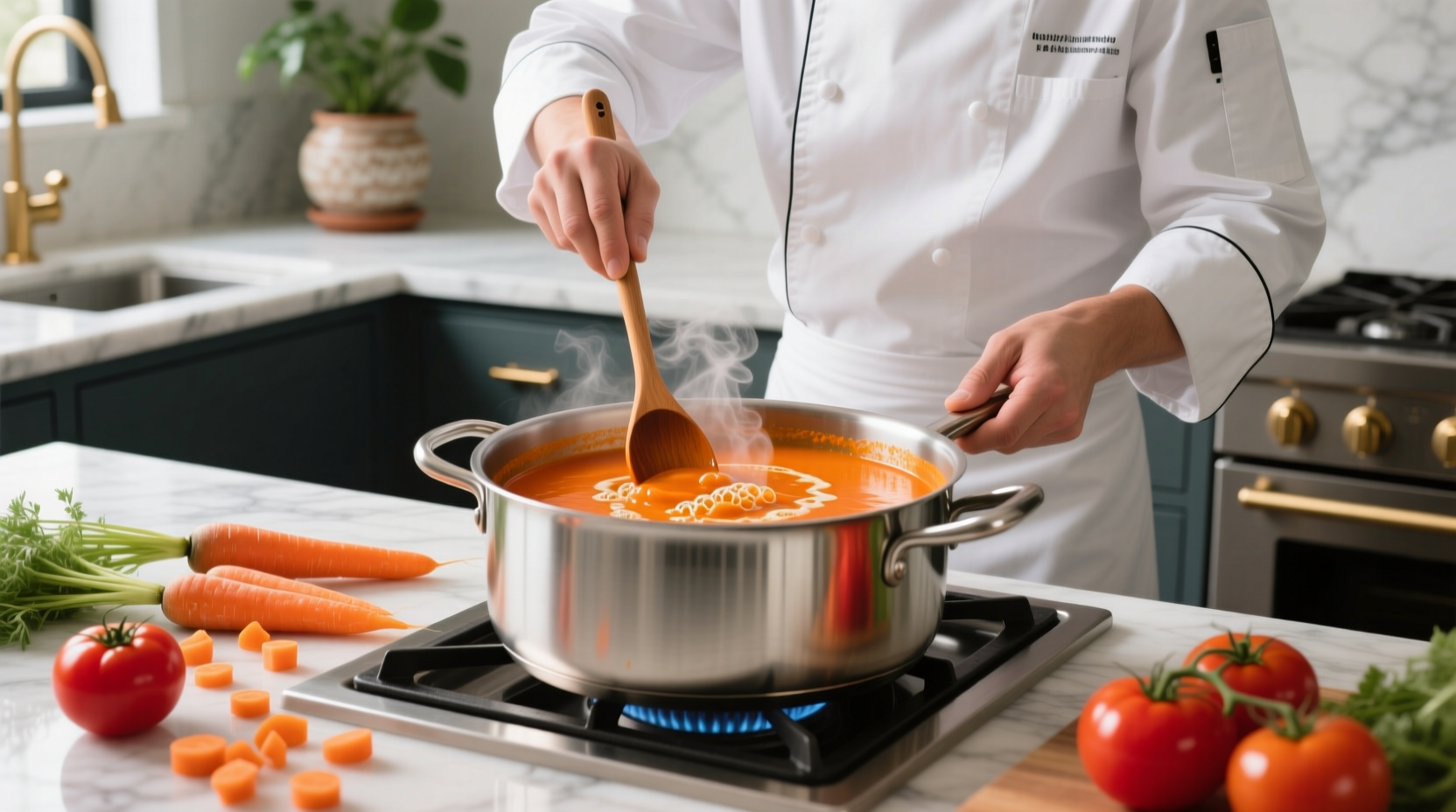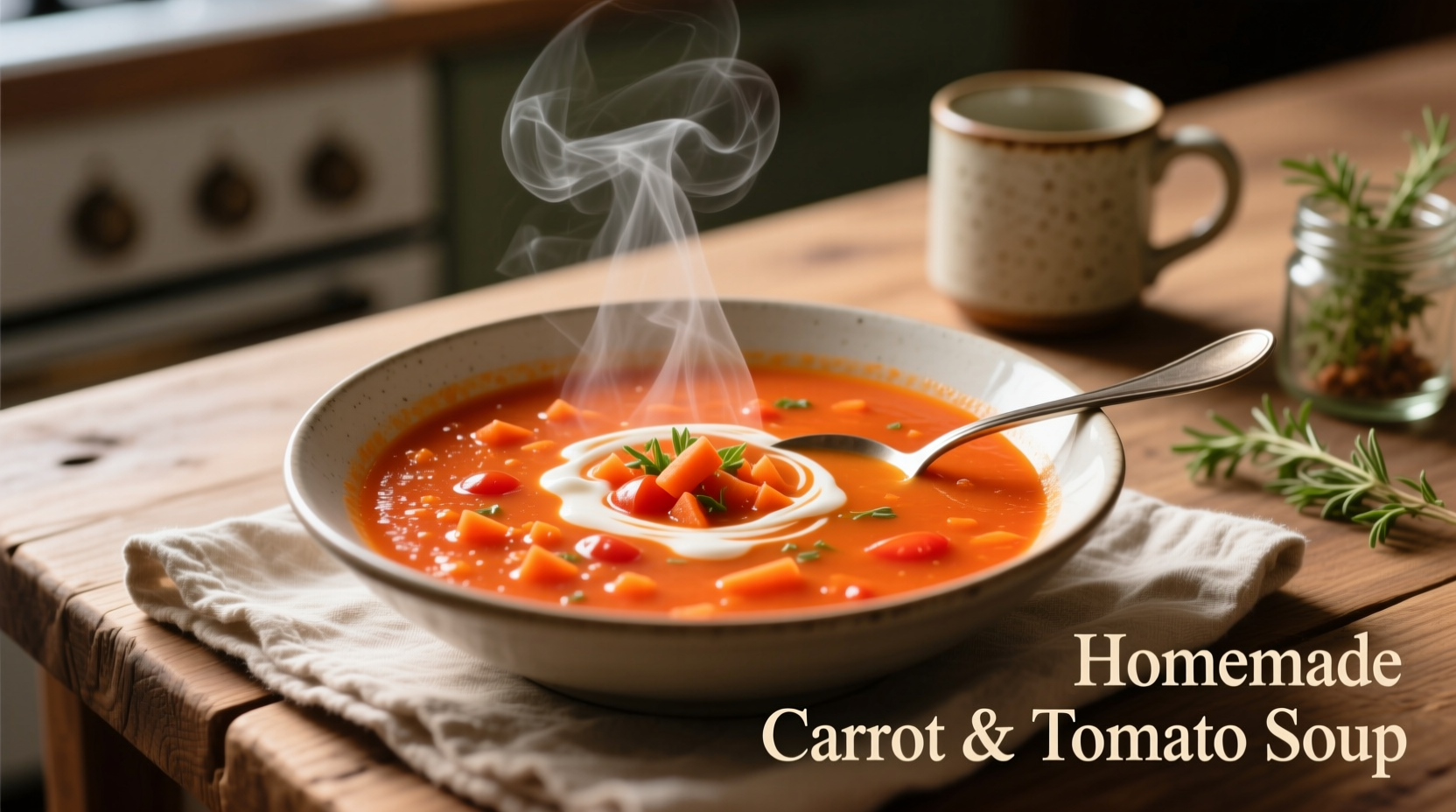Carrot and tomato soup represents one of the most nutritionally intelligent flavor pairings in culinary science. The natural sweetness of carrots perfectly counterbalances tomatoes' acidity, while their complementary nutrient profiles create a health-boosting synergy rarely found in single-ingredient dishes. This classic combination has evolved from humble peasant food to restaurant staple through centuries of culinary refinement.
The Science Behind This Flavor Partnership
When carrots and tomatoes share the same pot, something remarkable happens beyond simple flavor blending. According to research from the USDA Food Research Laboratory, the fat-soluble carotenoids in carrots (particularly beta-carotene) become significantly more bioavailable when cooked with the lycopene-rich tomatoes. This nutrient synergy means your body absorbs up to 30% more antioxidants from this combination than from either ingredient consumed separately.
| Nutrient | Carrots (1 cup) | Tomatoes (1 cup) | Combined Effect |
|---|---|---|---|
| Beta-carotene | 16,706 IU | 82 IU | Enhanced absorption |
| Lycopene | 0 IU | 7,298 IU | Stabilized by carrot fibers |
| Vitamin C | 9.6 mg | 24.7 mg | Preserved longer in combination |
Historical Evolution of Carrot and Tomato Soup
The journey of carrot and tomato soup reflects broader culinary history. While carrots have been cultivated since the 10th century in Central Asia, tomatoes didn't reach European kitchens until the 16th century. Initially considered poisonous, tomatoes gradually gained acceptance, with the first documented carrot and tomato soup appearing in French culinary texts around 1820.
1820s: First French culinary texts mention "soupe de carottes et tomates" as a remedy for digestive issues
1890s: Italian immigrants introduce variations with basil and olive oil to American kitchens
1940s: WWII rationing makes this vegetable-based soup popular across Europe
1980s: Emergence of blended versions using new immersion blender technology
Present: Recognized by culinary institutions as a nutritionally optimized classic
Essential Ingredients Selection Guide
The quality of your ingredients determines 80% of your soup's final character. For authentic carrot and tomato soup that shines:
- Carrots: Choose deep orange, firm carrots with minimal branching. According to the University of Minnesota Extension, late-season carrots contain up to 40% more beta-carotene than early harvest varieties
- Tomatoes: San Marzano varieties provide the ideal balance of sweetness and acidity. When fresh tomatoes aren't in season, high-quality canned whole tomatoes actually contain more lycopene due to the heat-processing effect
- Aromatics: Yellow onions rather than white create a more complex flavor foundation. The sulfur compounds in yellow onions caramelize more evenly
- Fat component: Extra virgin olive oil enhances nutrient absorption while adding distinctive flavor notes

Step-by-Step Preparation Method
Professional chefs achieve restaurant-quality texture through controlled cooking stages. Follow this sequence for optimal results:
- Sweat aromatics: Cook diced onions in olive oil over medium-low heat for 8-10 minutes until translucent but not browned. This develops flavor without bitterness
- Toast spices: Add garlic and dried herbs (thyme works best), cooking for 60 seconds to release essential oils
- Build flavor foundation: Add chopped carrots and cook for 5 minutes to develop natural sugars
- Add tomatoes: Pour in tomatoes with their juices, scraping the pot bottom to incorporate fond
- Simmer gently: Add vegetable broth (4 cups per 2 lbs vegetables), bring to simmer, then reduce heat. Cover and cook 25-30 minutes until carrots pierce easily with a fork
- Blend to perfection: Use an immersion blender for safest results. For ultra-smooth texture, pass through a fine-mesh sieve
Avoiding Common Texture Problems
Texture issues represent the most frequent failure points in homemade carrot tomato soup. Understanding these context boundaries prevents disappointment:
- Too thin: Caused by excess liquid or insufficient carrot content. Fix: Simmer uncovered 5-10 minutes or add 1-2 tbsp tomato paste
- Too thick: Often from over-reduction. Fix: Add broth or water ¼ cup at a time while reheating
- Grainy texture: Results from improper blending while hot. Fix: Let soup cool slightly before blending, and blend in batches if using countertop blender
- Separation: Occurs when fat and liquid components don't emulsify. Fix: Blend while warm (not hot) and incorporate fat gradually
Customization Options for Dietary Needs
This versatile recipe adapts beautifully to various dietary requirements when you understand the functional role of each component:
- Vegan version: Use olive oil instead of butter. For creaminess without dairy, blend in ¼ cup cooked white beans
- Low-sodium option: Replace broth with water and add 2 tbsp nutritional yeast for umami depth
- Keto adaptation: Increase olive oil to 3 tbsp and add ½ avocado during blending for healthy fats
- Allium-free version: Substitute fennel bulb for onions, using only the white base portion
Serving and Storage Best Practices
Maximize flavor and nutrition through proper finishing and storage techniques:
- Acid balance: Add a splash of lemon juice or sherry vinegar just before serving to brighten flavors
- Garnish strategically: A swirl of plain yogurt provides protein contrast, while fresh basil adds aromatic complexity
- Storage: Keep in airtight containers for up to 4 days. The FDA recommends cooling soup to room temperature within 2 hours before refrigeration
- Freezing: Portion into freezer-safe containers with 1-inch headspace. Maintains quality for 3 months
Frequently Asked Questions
Can I make carrot and tomato soup without broth?
Yes, you can substitute vegetable broth with water plus 2 tablespoons of tomato paste and 1 teaspoon of nutritional yeast. This combination provides the umami depth typically contributed by broth while maintaining the soup's vegetarian status. The resulting flavor will be lighter but still balanced.
Why does my carrot and tomato soup taste too acidic?
Excessive acidity usually occurs when using underripe tomatoes or insufficient carrots to balance the pH. To correct this, add ½ teaspoon of baking soda (dissolved in 2 tablespoons of soup first) or 1 tablespoon of honey. Carrots naturally contain sugars that counteract tomato acidity, so increasing the carrot-to-tomato ratio in future batches prevents this issue.
How can I make my carrot and tomato soup creamier without dairy?
For dairy-free creaminess, blend in ¼ cup of cooked cannellini beans or ½ ripe avocado with the soup. Both options add body without altering the fundamental flavor profile. Roasted cauliflower (½ cup) also creates a velvety texture while complementing the existing vegetable flavors.
What's the best way to freeze carrot and tomato soup?
Cool the soup completely, then portion into freezer-safe containers with 1-inch headspace for expansion. For easiest use, freeze in silicone muffin cups then transfer the portions to a freezer bag. Properly stored, the soup maintains quality for 3 months. When reheating, add a splash of water or broth as freezing can concentrate flavors.
Can I use frozen carrots for this soup recipe?
Yes, frozen carrots work well in soups, though they may yield a slightly softer texture. Use them directly from frozen without thawing to prevent mushiness. Increase cooking time by 5-7 minutes to ensure proper flavor development. For best results, choose flash-frozen carrots without added seasonings or sauces.











 浙公网安备
33010002000092号
浙公网安备
33010002000092号 浙B2-20120091-4
浙B2-20120091-4